U5 Europaviertel Frankfurt am Main

Infrastructure
Factbox
Client: SBEV Stadtbahn Europaviertel Projektbaugesellschaft mbH
Contractor: ARGE aus PORR Deutschland und Stump Spezialtiefbau
Project Type: Civil engineering, Tunnelling, Specialist civil engineering, Structual engineering
Scope: Construction of a 1,160m long underground route section including connection to the existing route and construction of a station
Contract Volume: EUR 120 million
Construction Start: 02/2017
Construction End: 2023
Location: Frankfurt am Main
Stadtbahn Europaviertel Projektbaugesellschaft mbH awarded the U5 Europaviertel consortium to build a 1,16m long underground section of the U5 city rail line.
Starting at the Platz der Republik, it runs via four stations into Frankfurt's Europaviertel. The consortium, consisting of the tunnelling, civil engineering and special civil engineering divisions of PORR Deutschland, will carry out the structural work for the Güterplatz station.
Over the last twenty years, the site of the former Frankfurt freight station has been home to a newly emerging district: the Europaviertel. Around 30,000 people will ultimately live and work in this city-centre district. In order to accelerate integration of the new quarter, transport connections to the U5 city rail line are being optimised. Extending the route beyond the main rail station to the west will provide the expanding neighbourhood with a high-capacity connection to the city's public transport network.
This involves extending the existing line along the Europa Allee by adding a new 2.7km section and four stations: the new line will run through the Güterplatz, Emser Brücke and Europagarten stations to terminate at Wohnpark. Around 920m of the line, including the Güterplatz station, is underground, as is the connection to the existing structure at the Platz der Republik. The turf-cutting ceremony for the project took place on 21 September 2017 and the line is scheduled to begin operating in 2024.
The project
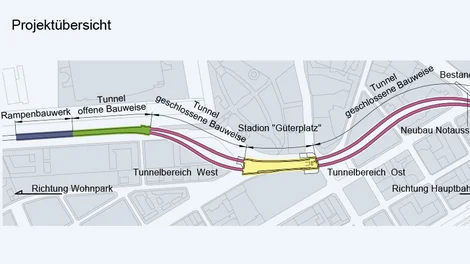
The contract comprises construction of the city centre underground rail extension and the underground connection to the existing underground rail network.
The tunnel is being constructed using the cut-and-cover method for a section of around 186m length, and bored for a section of around 2 x 830m, using an 80m long tunnel boring machine (TBM). The contract also includes a ramp structure around 137m long, plus the construction of the Güterplatz station, located around halfway along the new route section. The underground connection to the existing network is being carried out using conventional construction methods, aided by ground freezing, injection and compressed air.
In the eastern part of the Europa Allee, Stump has already completed the work on the slurry walls of the 18m deep launch pit from which the TBM will start excavations. Slurry walls are also being constructed at the site of the future Güterplatz underground station, in preparation for the erection of the construction pit walls – but excavation work there cannot commence until both tunnel tubes have been bored.
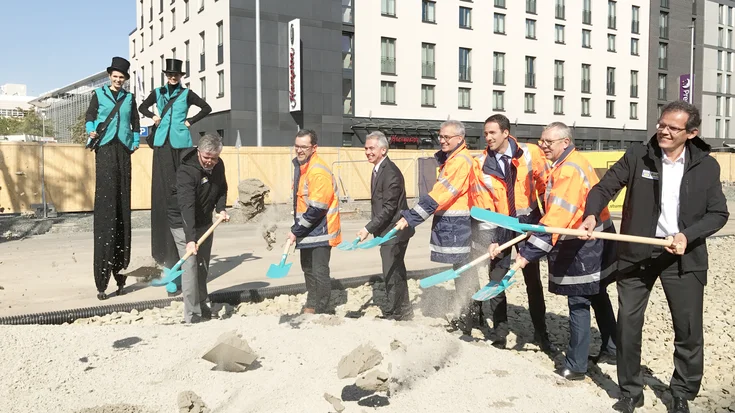
The two tunnels are being bored in turn at 1,305HP, from the launch pit to the existing structure at the Platz der Republik. After the first run of the TBM, the machine core will be removed and the TBM retracted to the launch pit. It will then be placed into the second tunnel and a new shield skin used for the TBM’s second run. Based on current progress, this process will take around twelve months for the two tunnel tubes. The machine assembly time must be added to this, as must the time taken to retract the machine and transfer it to the second tunnel.
In order to avoid damage to structures, we meet the high requirements for urban tunnel excavations.
Technical support, PORR Deutschland
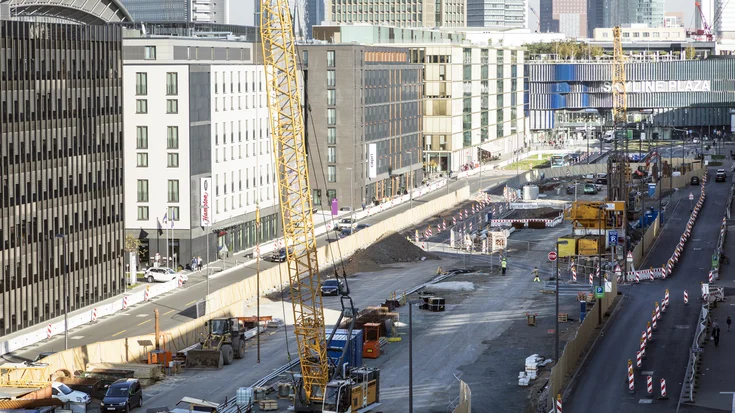
Traffic diversions
City-centre tunnel works cause significant challenges for daily traffic flows in two respects: Firstly, traffic diversions and road closures are necessary to make room for construction sites and pits. Secondly, all the transport logistics required to deliver materials to the construction site and dispose of waste also take place via public roads and transport routes, thereby considerably increasing both traffic and the risk of traffic jams. In order to minimise the negative effects on traffic in the metropolis, a detailed traffic plan was designed and individually adapted to each of the project phases.
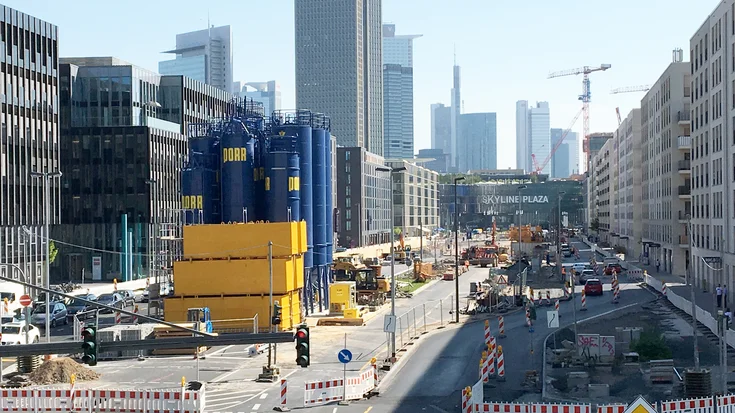
For the entire construction period, the two-lane carriageways on the Boulevard Ost have been reduced to a single lane in either direction, and shifted towards the building facades. New access routes to the Skyline Plaza shopping mall’s underground parking garage must also be created and integrated into the new traffic system. In addition, access to the construction site towards the east will take place along a newly created dedicated traffic lane, so that the already considerably restricted traffic flow will not be subject to further pressure from construction site vehicles travelling in and out.
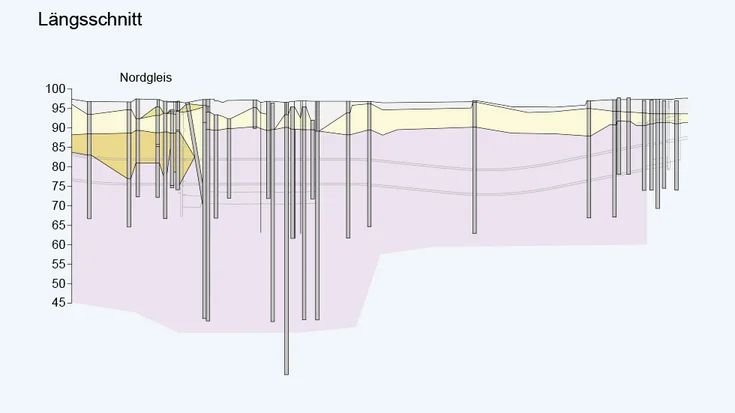
Geology
The geology in Frankfurt's city centre is notable for its cohesive soil with high proportions of clay and silt, and low permeability. The Frankfurt clay, through which a large part of the underground route runs, is of particular note. The clay layer is overlaid with several quaternary layers of sandstone and gravel up to 2-10m thick, which must be bored through from the launch pit to reach the clay layer. In some places, sandstone formations extend into the clay layer and appear at other points along the planned route.
The water table level in Frankfurt lies between 3 and 7m below the surface. The sandy covering layer has a high pore volume which acts as a ground water conductor with a high degree of permeability. The clay layer, however, has the opposite function and generally acts as a groundwater barrier, which means that the tunnel can be bored here without water pressure building up.
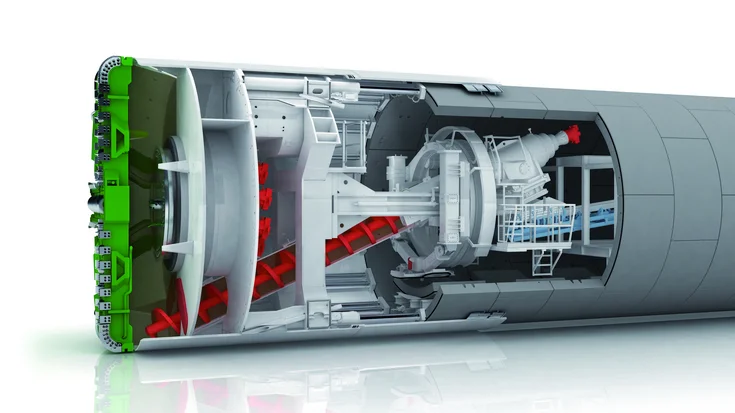
Boring method
The U5 extension is bored using a tunnel boring machine with earth pressure support (EPB-shield), which mixes the existing soil into a paste and uses it directly as a support medium. This process is particularly suitable for clay soils and is thus ideal for boring in Frankfurt's Europaviertel.
As the tunnels are being bored in a city centre location, the requirements for keeping subsidence at a minimum are extremely high. The TBM's supporting pressure must be configured in accordance with the surrounding subsoil and the applied loads, in order to avoid subsidence and any associated structural damage.
Machine details
- Manufacturer: Herrenknecht
- Model: S-1127
- Type: EPB (earth pressure blade)
- Nominal diameter: 7,100 mm
- Shield length: 9,200 mm
- Installed power: 960 kW
- Nominal boring power: 36.500 kN
- Number of boring presses: 12 Double presses
- Length of TBM + trailing support: Approx. 84m
- Total weight: Approx. 580t
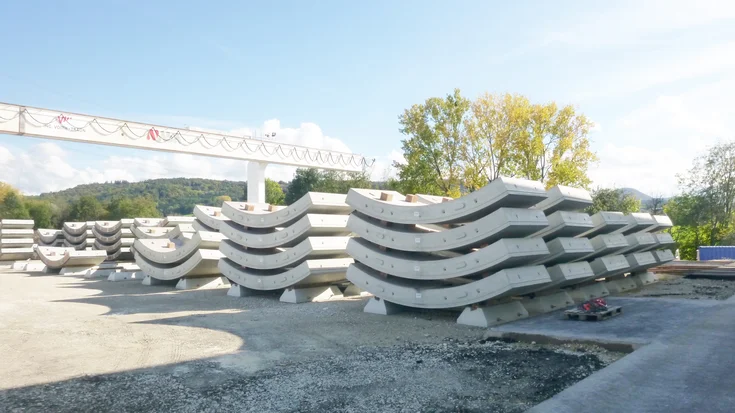
Segments
The bored cross section is lined with single-layer watertight lining segments. The precast reinforced concrete parts are manufactured by Rekers in Spelle and delivered by rail to an interim storage site in Frankfurt. Forklift trucks are used to unload the batches from the railway carriages and load them onto lorries for transport to the segment store at the construction site launch shaft on the Europa Allee.
Ring design
- Ring segments: 6+0
- Segment thickness: 45 cm
- Segment length: 1.20 m
- Ring diameter, external: 6.80 m
- Ring diameter, internal: 5.90 m
- Total weight of the ring: 27 tonnes
Connection to the existing network
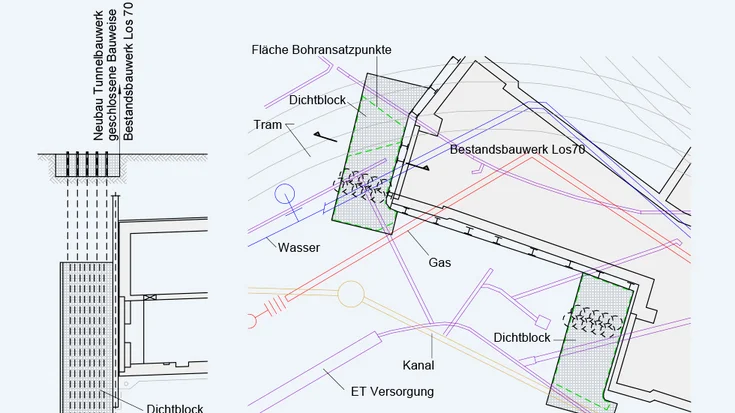
During earlier construction projects, underground branches for the new U5 line were created at the Platz der Republik near the main railway station; the two new tunnels will be connected to these. Getting the tunnel boring machines to arrive precisely at these existing constructions, given the geological situation and existing urban development, already presents one challenge; another consists of sealing the junction between the new and the existing structures. Initially, the plan was to achieve this using what are known as “sealing blocks” directly in front of theexisting construction. These blocks are comprised of numerous jet-grouted columns, where a rotating jet mixes the surrounding soil with a binding suspension containing cement to form a soil-cement structure. These sealing blocks were to have been manufactured on the surface, resulting in significant disruption to traffic, as the connection to the existing structure is located directly below one of Frankfurt's major junctions (Düsseldorfer Straße – Mainzer Landstraße).
Change in plans
In order to reduce the disruption and amount of construction work, the U5 consortium came up with a design for an alternative connection to the existing structure, and this was the design that was ultimately contracted. The plan differs from the originally planned waterproofing work primarily in that it includes neither the sealing blocks nor the ground freezing process from the surface. This has the advantage of leaving the road traffic undisturbed. In addition, the existing structure is actively cooled, thus safeguarding the ground-freezing unit and associated sealing of the connecting wall. Furthermore, compressed air is used for disassembly of the TBM and boring, in order to further ensure the waterproofing of the connecting works. The injection process and ground-freezing boreholes drilled from the existing structure will be carried out approximately according to the original plans.
Technical data
- Beginning of excavation works
01/2019
- End of excavation works
01/2020
- Tunnel length
1.672km
- Internal diameter
5.9m
- Machine type
Earth pressure balance shield
Summary
The underground section of the new U5 city rail line into Frankfurt's Europaviertel is a diverse and challenging project. Although this article has focused primarily on the tunnelling activity, the team's expertise is crucial for the success of the overall project. Different group competences
go hand-in-hand: civil engineers, tunnel construction engineers and specialist civil engineers must all share their knowledge and actively participate in ensuring the work is managed successfully. PORR has a strong team who is pulling together to ensure a successful project.





